Visiting Myanmar – A Land of Few Tourists
Disclaimer: Some links on this page may be affiliate links. If you purchase anything through them, I will receive a small commission at no extra cost to you!
Perhaps “the North Korea of Southeast Asia” would be a slight exaggeration, but visiting Myanmar is rare and the country gets very few tourists in comparison to its neighbours. This is partly due to the political situation, and partly due to the Western reporting of the situation in this country.
The media will tell you that Myanmar is a war zone. Read the small print however and you will realise that this does not apply to the whole country. If you stick to the touristy areas of Yangon, Bagan, Mandalay and Inle Lake you will not even notice any issues taking part in this country.
And reaching the more dangerous areas is virtually impossible to do by accident. You require permits to go to places in Myanmar that may be considered “off the beaten track”. Myanmar is safe for tourists who stick to the beaten path.
Arrival in Yangon
Day one involved a late arrival from Kuala Lumpur. I could tell instantly that they don’t get many foreigners here. People would approach me, the only white person in the airport, and attempt to sell (overpriced) SIM cards or exchange money at the official rate where $1 = 2,100 kyat (the local currency).
On day 1 in a new country I never like to be without internet. Especially in a slightly riskier country which I haven’t visited previously. Therefore I exchanged $50 at the weaker rates, spent over a quarter of that on a SIM and used Grab – the Southeast Asian Uber – to head to my accommodation for the first few nights.
The flooded bathroom smelled of sewage and turning the tap on would propel a jet of water towards the door, leaving very little to wash your hands with. Lovely start.
Day 2 started earlier than planned thanks to some idiot deciding to play loud rap music at 7am. Gave him the benefit of the doubt to begin with, but no, he genuinely thought it was acceptable to play loud (c)rap music in a shared room early in the morning. This wasn’t the only issue I would have with this character, although he spoke of carrying a weapon with him, therefore I decided against challenging him despite his attempts to act friendly at breakfast time… Visiting Myanmar hadn’t quite got off to the best of starts.
Exploring Yangon: The Number One City to Explore Whilst Visiting Myanmar
After breakfast, it was time to explore Yangon. The plan? To walk for 6+ hours in the baking heat between a variety of interesting destinations.
The journey involved walking through markets seeing the everyday life of the Burmese people. Locals selling fruits and chopping meat in the streets. Then I encountered an interesting chap. The birdman of Yangon. This aging gentleman stood with his bike and a cage full of birds.
Despite the language barrier, I understood exactly what he was doing. Never underestimate the power of body language and hand gestures in lieu of a shared language.
He wanted money. In exchange for payment he would release one of the birds. Never quite managed to work out how much he wanted however. And the birds remain caged. It turned out there were a handful of people in Yangon doing exactly the same “job”. Capturing birds to release for a fee.
The birdman was one of many picturesque locals I spotted whilst visiting Myanmar, with others shown below.
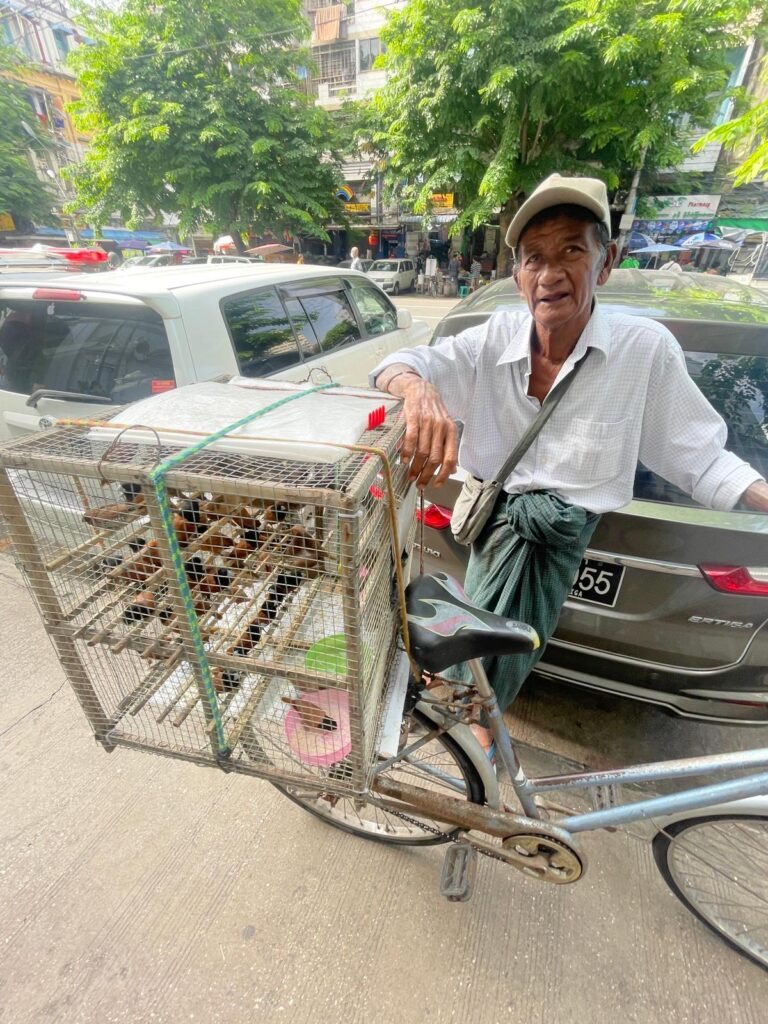
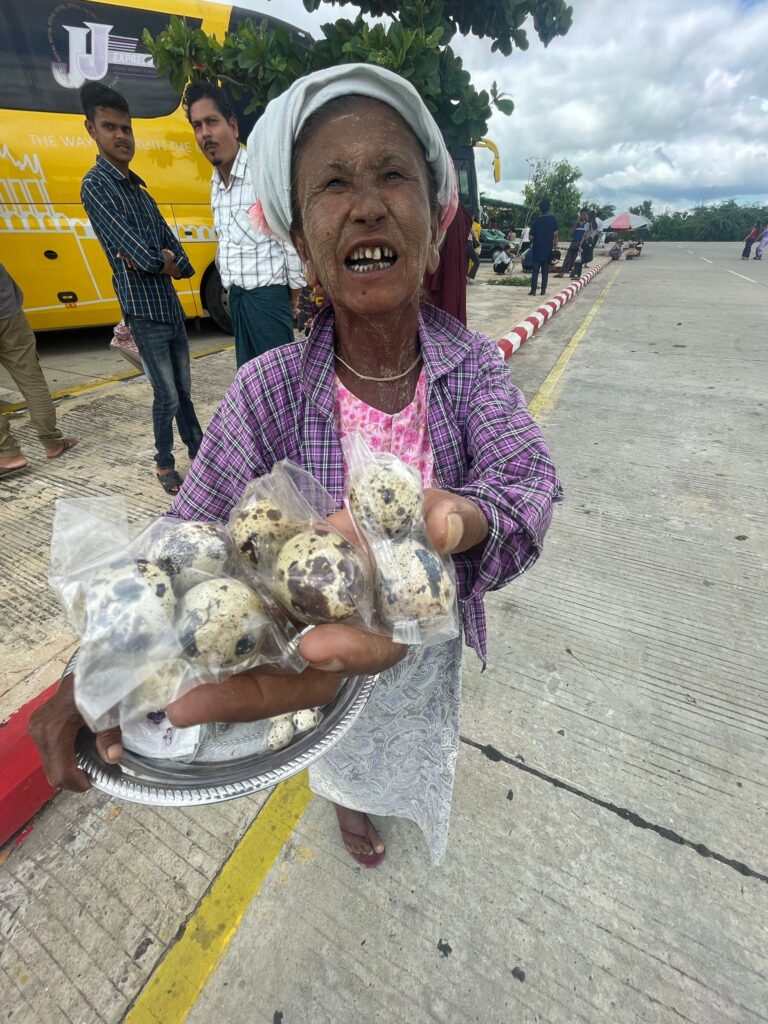
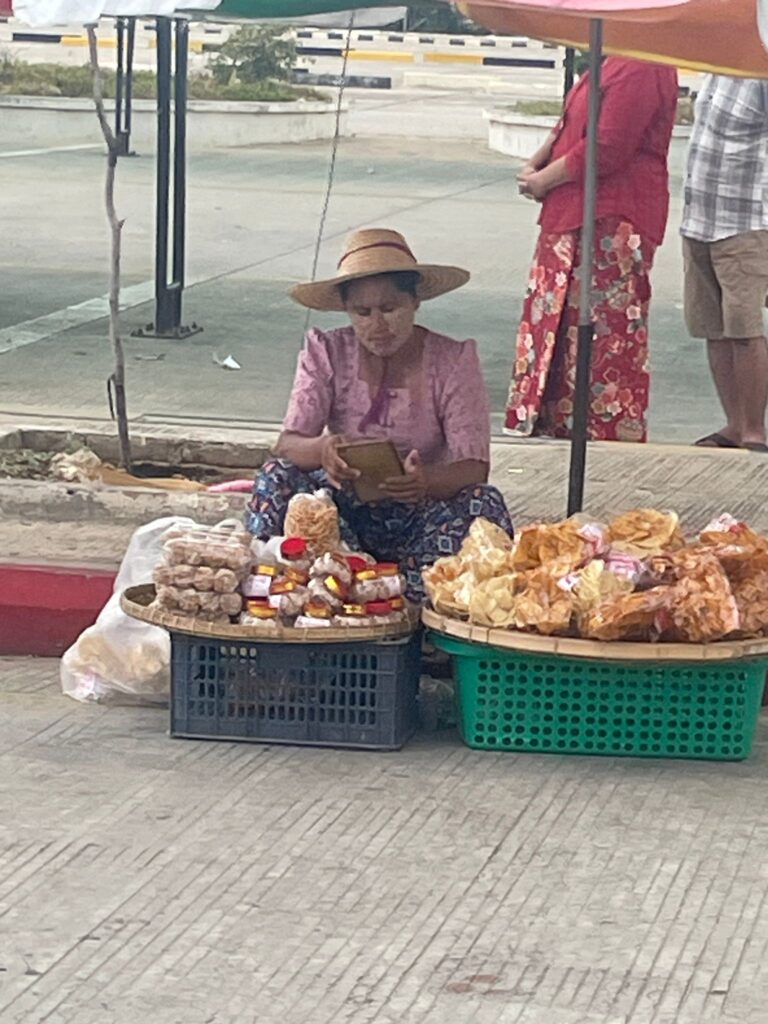
Eventually made it to the pagoda. Again, didn’t go in as I had my sights set on the big one later on. It was cool on the outside. But Shwedagon awaited.
After more walking I eventually reached a currency exchange I had seen recommended by recent travellers visiting Myanmar with black market rates 50% above the official rate. Unfortunately this was not my experience and the government rates were used here. Mission failed. Time to move on and try elsewhere.
The Highlight of Yangon
After a 3-hour break to avoid the rain, it was time to hit the big one. Shwedagon Pagoda is the most popular in Yangon. Unlike some pagodas, this one cost money to enter (10,000 kyat or $5 using the rate I had exchanged at in the airport). Was it worth it?
Absolutely!
After several flights of stairs you are greeted by an impressive golden stupa. But this is just the centrepiece. Many temples surround the stupa where Buddhists come to pray. Buddhist statues stand in many of the temples, and some corners provide spectacular views of the city.
In one temple, a group of women were chanting. In many others, people kneeled down in front of the impressive Buddhist statues. The only drawback of the pagoda was tour guides singling me out as the only obvious foreigner and trying to pester me into taking their tours. Overall however, this was one of the coolest religious sites I had ever seen. Absolutely worth visiting Myanmar to see this alone. Very few touristy spots have exceeded expectations as much as the Shwedagon Pagoda.
This was the best place I visited in Myanmar.
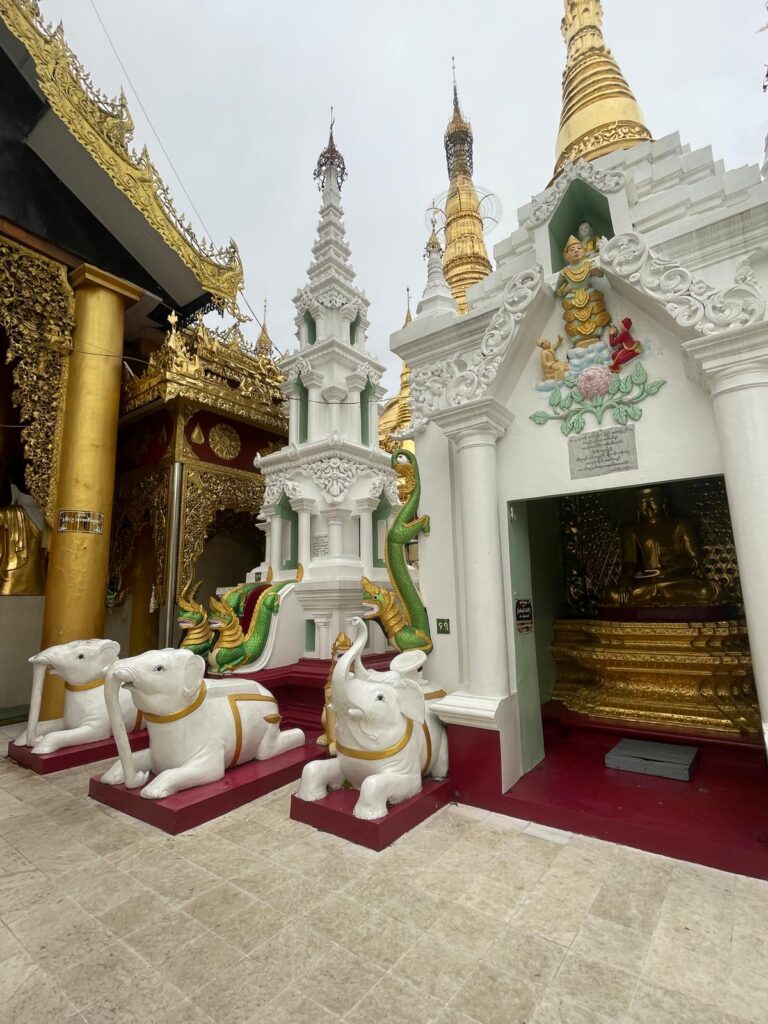
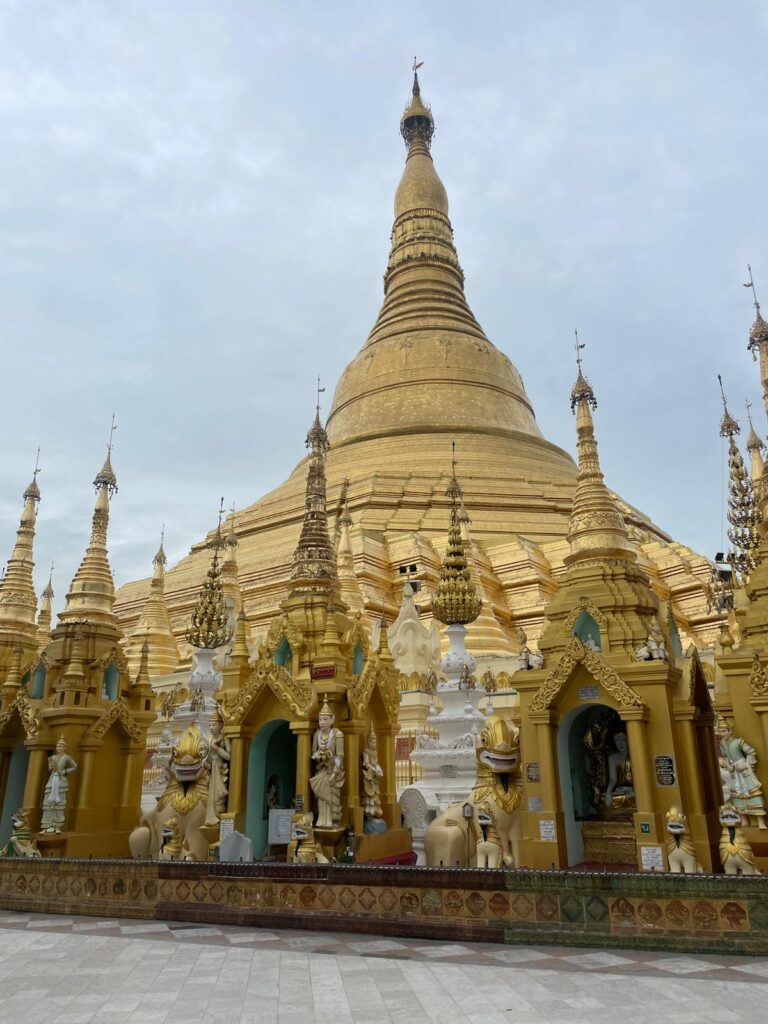

The Black Market Makes Visiting Myanmar Incredibly Cheap
Day 3 started with another early wake up call courtesy of some more (c)rap music. Finally I found a black market currency exchange which gave rates of $1 = 3,060 kyat, a major upgrade on the official rate of 2,100. Suddenly this country just became a whole lot cheaper.
A throwback to Argentina, which also has a much more favorable exchange rate if you look in the right places. The “right places” being the shifty chap down a dark alleyway over the humble bank employee. See my post on how to maximise your money in Argentina for more on that.
Whilst this can save you a lot of money, you should always take advice from trusted locals or recent travellers before doing something like this.
More of Yangon
Kandawgyi Lake was the first stop of interest on this day. A cool palace lies on the lake which was fun to see. Didn’t spend long here however due to the searing heat.
A trip to cool off in a shopping mall was disrupted by a power cut. Myanmar has several electrical blackouts on a daily basis. Some places have generators which nullify the issues, however others will plunge you into darkness for several hours. It can be quite dangerous to go out at nighttime, not because of crime, but because there are many hazards which are difficult to avoid in the darkness.
The paths are unstable with large holes, it’s very easy to trip if you don’t watch your step. If you’re extremely unlucky then you could fall into one of many sewage rivers which can often be found alongside the paths in all parts of the country I visited. Visiting Myanmar isn’t quite as simple as visiting Germany or Singapore.
After the mall was the day’s highlight – Chaukhtatgyi Buddha Temple. A giant reclining Buddha the size of many houses combined. It lay on its side as people prayed before it. The temple was free to enter and well worth the sweaty walk. After Shwedagon Pagoda, this was the second best place visited in Yangon.
Aside from the giant Buddha, there were several other cool spots within the temple. Many smaller Buddhist statues stood in all corners. One of my favourites was a statue of a monk which looked like a dead-ringer for Barack Obama. Colourful images adorned the walls. Something synonymous with Asian religious temples. Or Hindu and Buddhist to be more specific.
This was it for Buddha-spotting on day 3. However, there was one final stop to go.
Football Adventures in Myanmar
As a massive football fan, I try to attend a top-flight game in every country. This was no exception whilst visiting Myanmar. Dagan FC played at home against Rakhine United in the 50,000-seater Thuwunna Stadium also used by the Myanmar national team. Expectations were that it would not be possible to get to a game. Myanmar does not like large crowds due to the volatile political situation and the potential for gatherings to escalate into violence.
Therefore after a long walk down many dusty roads in the searing heat, I arrived at the ground expecting to find it locked up.
This wouldn’t be the first such case. I was turned away from a game in Egypt as fans had been banned for many years after rioting killed several at a match. I did manage to sneak in on that occasion with help from a car park attendant and his friends. Perhaps this would not be such a wise move in Myanmar. Although it probably wasn’t a particularly smart idea in Egypt to begin with…
The ground appeared empty with no one around. Time to walk around the large stadium to see if there were any people around or entrances that were unlocked.
Sure enough two guys were sat by a gate. One gestured to say I was not allowed in there, but could try a turnstile just up the road.
As it turned out, this turnstile was manned. And the attendant was able to sell me a ticket for just 3,000 kyat. Around £0.80.
I headed up the stairs into the ground and got my first glimpse of this vast arena.
Unlike many grounds, there wasn’t a single person selling food or drink here. And the crowd of around 100-200 failed to make much noise inside this vast arena.
A Taste of Burmese Football – Is Visiting Myanmar for Football Worthwhile?
The visitors surged into a 2-0 lead, in part thanks to a slick passing move Pep’s prime Barca side would’ve been proud of. The showboating started soon afterwards with a visiting winger attempting to perform a rainbow flick over the defender’s head. The game finished 3-1 to the visitors, working out at a bargain cost of around £0.20 per goal.
By contrast, the same scoreline in the Premier League would cost around £10 per goal. And as a Southampton fan the majority of those would come against my team!
Burmese football wasn’t high on quality or atmosphere, yet provides great value for money. This is no Brazil or Argentina. Coming to Myanmar solely for the football is not a worthwhile experience. But if you’re here anyway, it’s a cool thing to do on a low budget.
One Grab taxi later and it was time to sleep ahead of a 10+ hour bus journey to Bagan the following day.
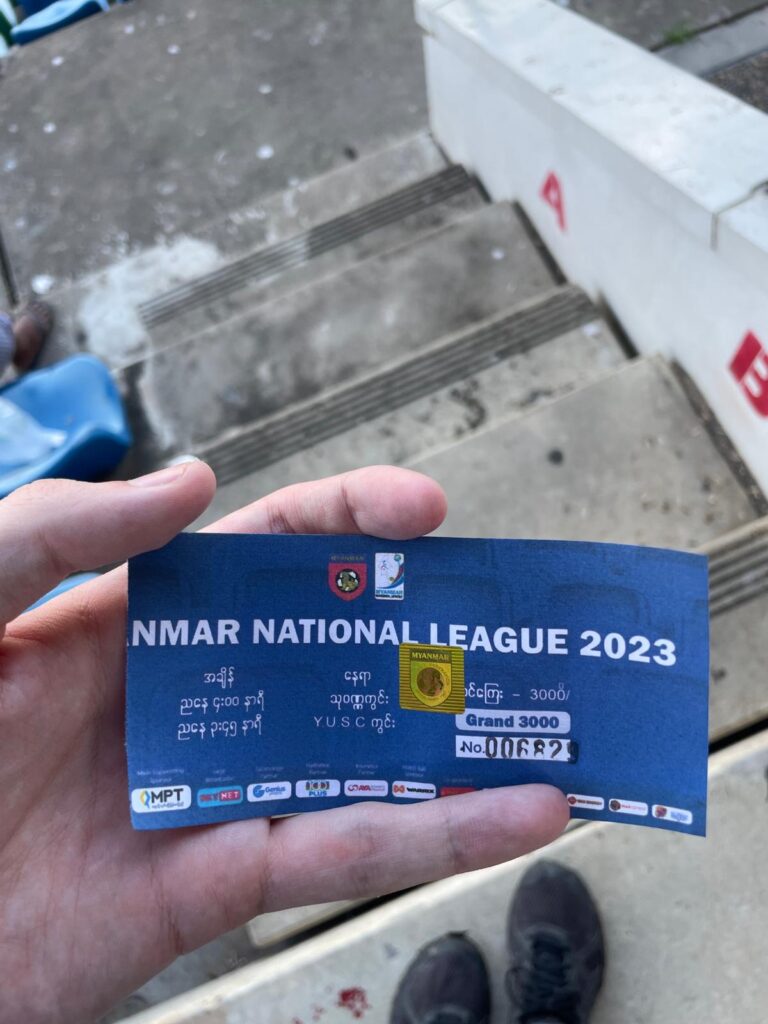
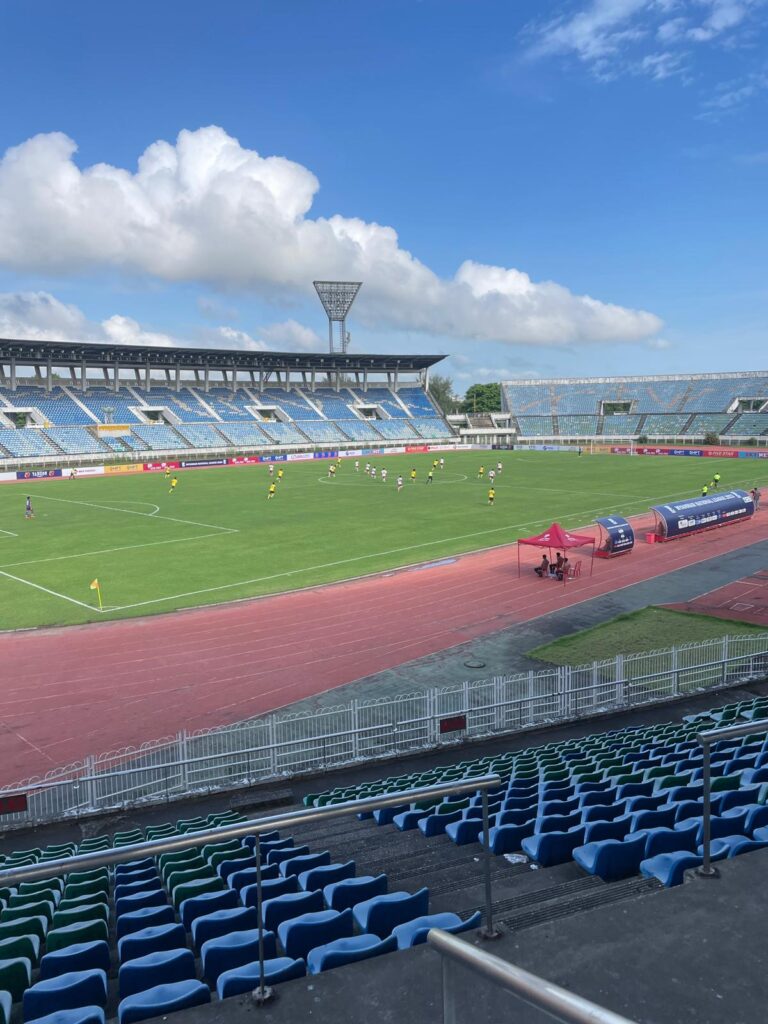

The Journey to Bagan
When visiting Myanmar your accommodation staff will often help book buses for you. Buses are cheap averaging around 30,000 kyat (£10) for a 10+ hour journey. Foreigners are only allowed on buses with certain companies, and this particular journey with Mandalay Minn was surprisingly comfortable. Although a jumper was necessary with the air con turned up to full blast. An odd feeling when the bus stopped for lunch and you walked out into the baking Burmese sun dressed for winter.
By late afternoon the bus arrived in Bagan. A man immediately came over as we departed the bus and asked if I wanted to rent a car. I told him I was just looking for a taxi and he told me he could drive to New Bagan where my accommodation was located. He know where I was staying before I told him, purely because there is only one hostel in Bagan and almost all foreigners stay there.
A Stroke of Luck, and First Impressions of Bagan
Apparently you are meant to pay 25,000 kyat (£8) upon arrival at the airport or bus station. This will allow you access to the 2,000 temples spread across a vast plain, which is the reason for visiting this place in the first place.
However, I never saw anyone selling tickets. The taxi driver took me directly from the bus to his car and we left from there. Perhaps he helped me unknowingly bypass the entry fee. Or perhaps it doesn’t exist now visiting Myanmar is such a rarity (I saw 5 other obvious foreigners in 11 days, although it seems there are a few tourists from China, Cambodia and other nearby countries who visit).
Bagan is incredibly undeveloped. Despite once being the primary tourist spot in the country, it retains a very authentic feel. If you come here looking for McDonald’s or Starbucks, you will be very disappointed. Even the restaurants are small wooden shacks reminiscent of the many village houses round here. Bagan is a different world in comparison to Paris or New York.
And the restaurants almost exclusively serve Burmese cuisine. There were a couple of places advertising Chinese or Thai food. However, these were closed. If you want western food, you won’t find it in Bagan. A business opportunity? Well perhaps if you can set up a profitable business likely to average under one customer per day. Visiting Myanmar is tricky if you aren’t keen on the local cuisine.
The Land of Snakes and Temples… Biking in Bagan
The following day was the big one. Time to hire out an e-bike and ride between many of the temples which make Bagan so spectacular.
The bike was like a cross between a scooter and a motorbike. Having never ridden one of these before, I was a little nervous, in particular when the lady at my hostel who arranged the rental said I don’t need a helmet… I insisted and she quickly changed her tune and found one round the corner. This at least calmed my nerves a little.
She showed me how to operate the bike. Eventually it was time to go, down the dusty roads of Bagan, which fortunately aren’t overwhelmed with traffic. Motorbikes make up the majority of traffic followed by tuk tuks, cars and the occasional bus.
The first few minutes were ultra cautious riding at a very slow pace, happily allowing other vehicles to whizz past. Straight roads were fine, however turning corners was problematic.
The bike could not make sharp turns due to the handlebars hitting my legs during any attempt to turn. Like many things in Asia, these bikes were built with the local population in mind.
Asians are generally much shorter than Europeans and the infrastructure accommodates that. I’ve hit my head on many Asian door frames due to the fact they aren’t built for people over 6ft tall. And still have memories of an uncomfortable “bed” on a Vietnamese sleeper bus built for people 5ft5 or under. When visiting Myanmar, the situation is no different.
As a result, turning required a wide berth, often heading onto the opposite side of the road to move around corners. This meant having to be ultra alert to surrounding traffic and other potential obstacles.
Time to Temple Hop
Within a few minutes it was time for temple number one. I saw this one beside the main road and decided to see what it had to offer.
The grass was overgrown outside. This is potentially very dangerous since Bagan is home to many venomous snakes which thrive in this environment. The medical facilities in Myanmar are notoriously poor at the best of times, even in the big cities.
In Bagan the infrastructure is even less. What this means is that you want to avoid an incident at all costs. They may be able to help should you have a minor bike accident, but good luck if you end up on the wrong side of a dangerous serpent. You’ll need it.
I carefully tiptoed through what vaguely resembled a path through the grass, stepping loudly to alert the local wildlife of my presence. Most snakes are timid and will retreat if they hear humans coming. A snake is at its most dangerous when caught out by surprise.
Snakes have also been known to frequent the temples, which offer a retreat from the baking hot sun. This particular temple appeared untouched for a long time with cracks in the walls, broken tile slabs and a Buddha statue covered in dirt.
I carefully entered, cautiously looking into dark corners for any unwanted guests on the way in. But everything was visible from the doorway, meaning it was time to head back through the overgrowth and ride to temple number two – the Shwesandaw Pagoda.
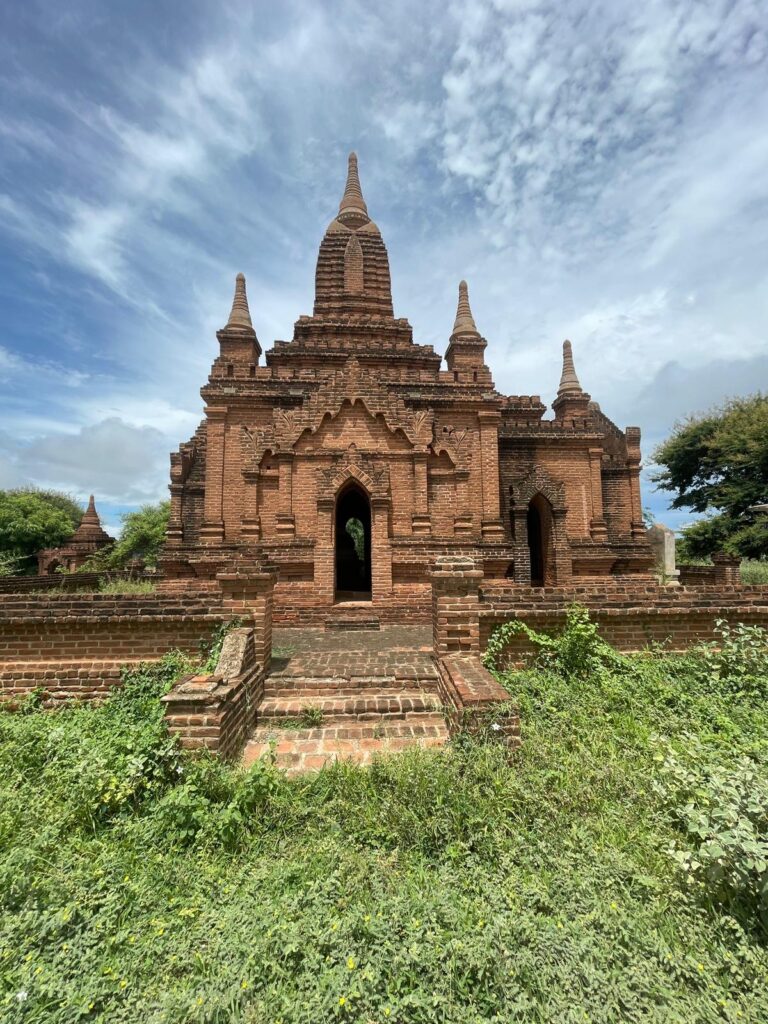
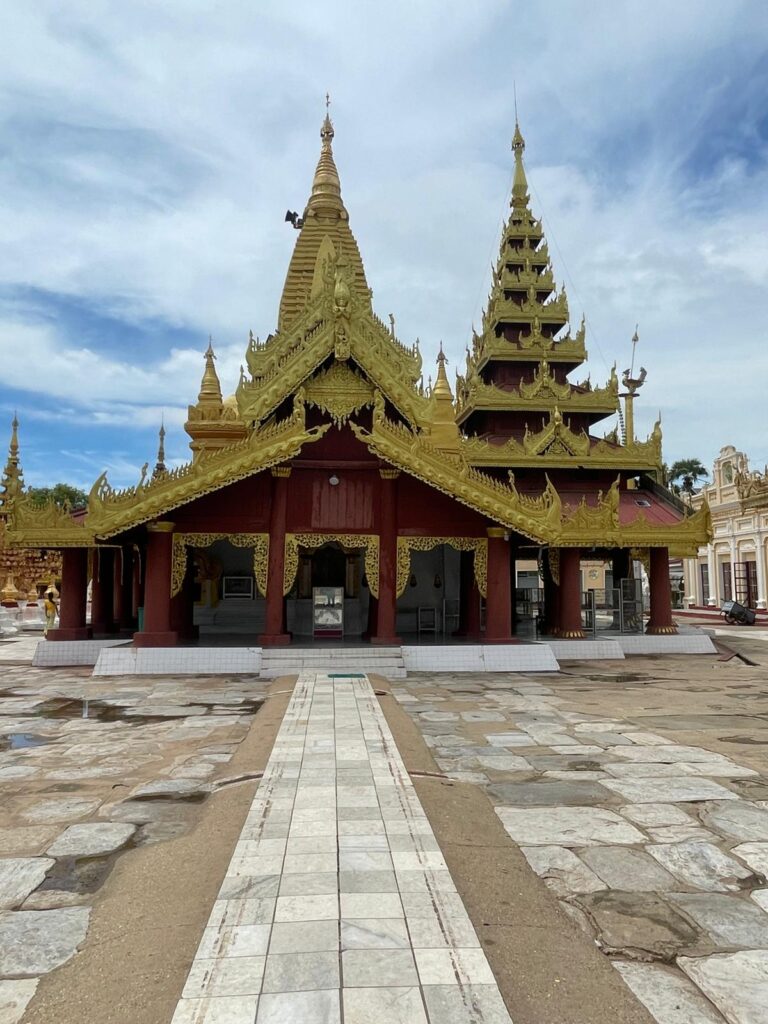
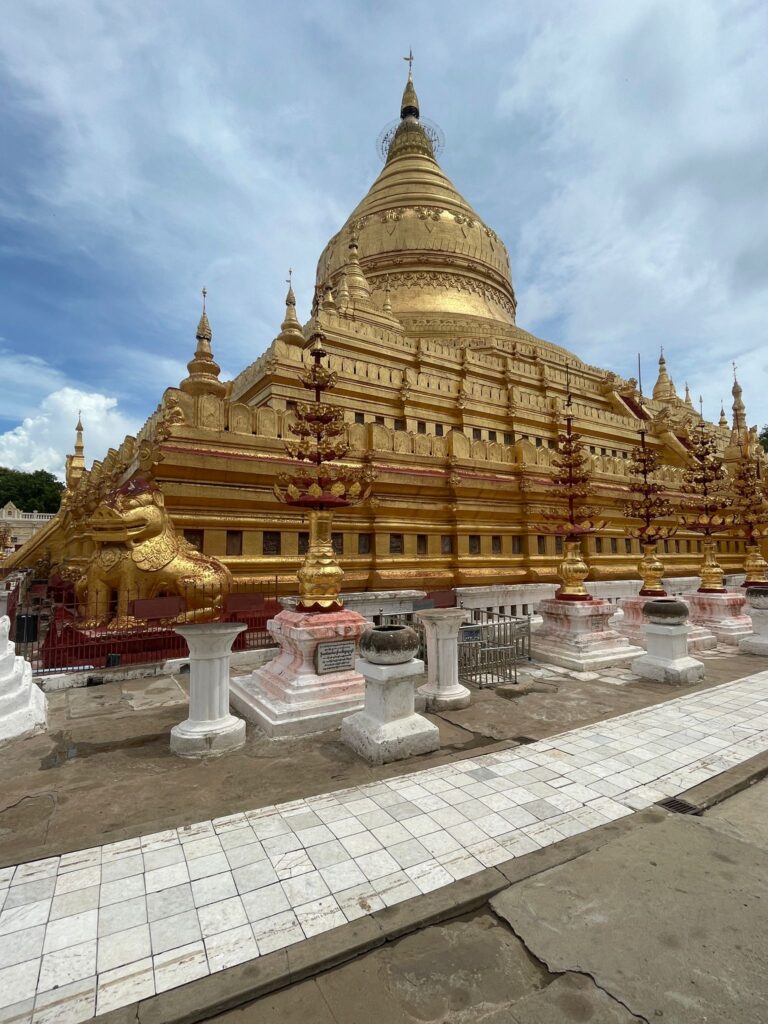
Temples and Tourist Traps
This was the first of ten temples I’d marked down on maps having read a “best temples to visit in Bagan” post. However it was annoyingly “touristy” despite no other tourists being there. Immediately I was approached by a mother and child trying to sell postcards and other tat I didn’t want.
I soon learned my first sentence in Burmese.
It turns out “no thank you” is the Burmese term for “please follow me around and persistently try to sell stuff I have repeatedly said I do not want”.
Ultimately I gave up on the idea of visiting this temple. Pest culture is one of the biggest downsides of travel. This applies to many countries across the world in popular tourist areas, however it is particularly bad in certain parts of Asia (India, I’m looking at you…). A disappointing start to temple-hopping in Bagan. Cannot say I expected this sort of encounter whilst visiting Myanmar.
Onto the next few temples. Fortunately this first major stop was the only one with real pest issues. Many of the temples that followed were closed. Others were very impressive.
Adventures in the Plains, and How to Maximise Your Experience Whilst Visiting Myanmar
In the dry season from October to April, it is possible to see sunrise over the plains from a hot air balloon, starting from around $200 per person. Whilst I visited at the wrong time of year, this is said to be spectacular and one of the all time travel bucket list items, comparable to hiking through Patagonia, or visiting the Great Pyramids of Giza.
After several more temples it was time to ride through a local village for the last one. However I took a wrong turn and ended up riding through an ankle-deep puddle. I lost balance and the bike fell. Sticking a foot out didn’t prevent me from covering my trousers in filthy water. The aftermath involved lifting the heavy bike out of the water and continuing onwards. After this, the bike would only work on 50% of the occasions I turned the engine on. They clearly weren’t built for idiot English tourists to give them a good soaking.
The final stop was Shwezigon Pagoda, which was much more touristy than others with souvenir shops lining the entrance. However it was perhaps the most spectacular of all with a stunning gold pagoda surrounded by various temples. It felt like a mini Shwedagon Pagoda.
The ride back passed without incident and the final stop was the banks of the Irrawaddy River for sunset. Locals lined the shores and some would head down the river on wooden boats of a particularly dubious quality. Unfortunately July was the wrong time of year for the best sunsets. However it was still a solid 7/10 spectacle. If you insist on visiting Myanmar during the right season then you’re in for a treat.
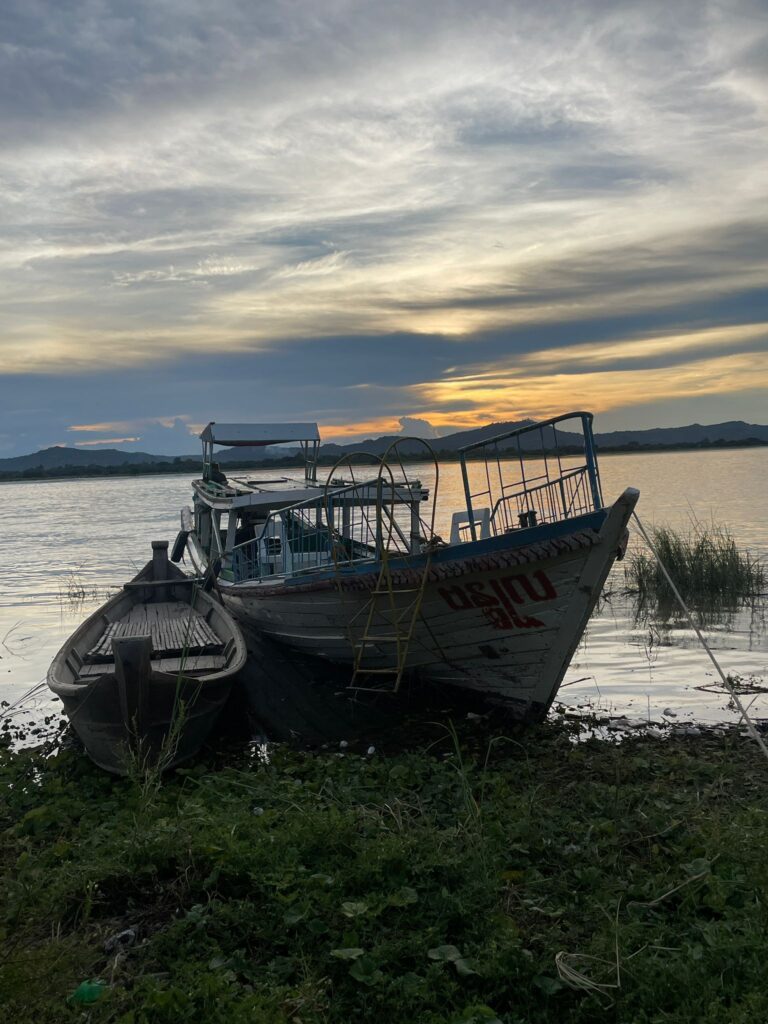

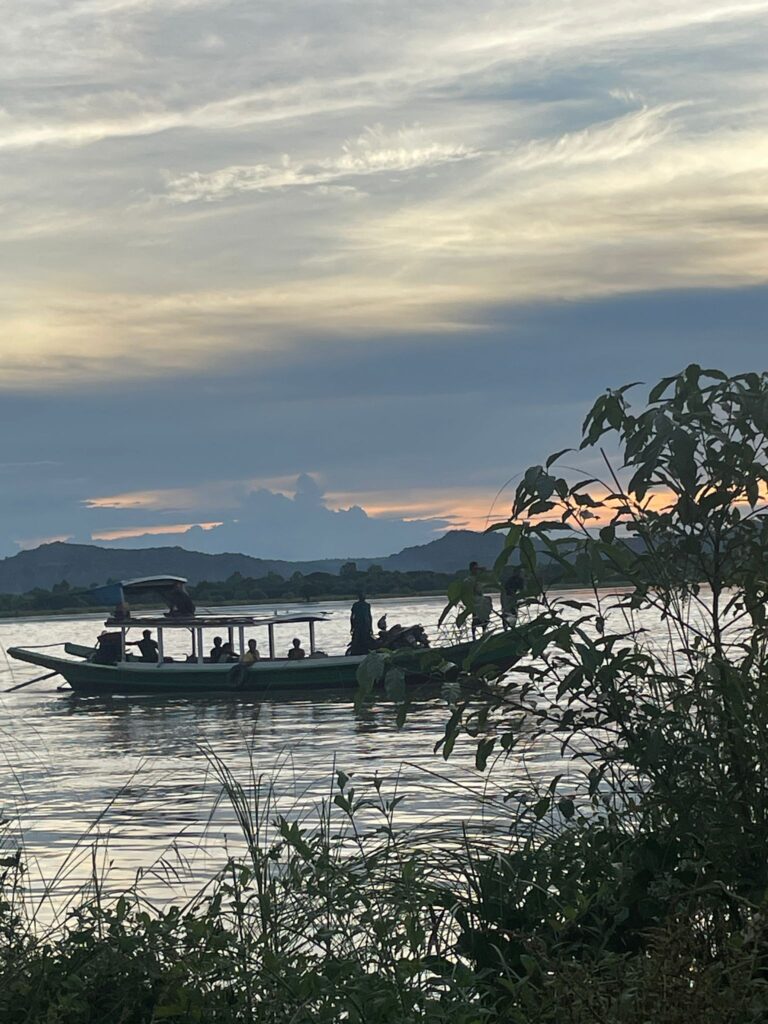
Dangers After Dark
It was finally time for the short ride back to the accommodation. A couple of hours after handing the bike back, I walked 5 short minutes to the local shop. Although after dark this was anything but easy.
My phone gave off very little light. In fact it was the only light source at all. Street lighting isn’t a thing in Bagan. Suddenly the barking started. The stray dogs which had been quiet throughout the day had suddenly come alive and they were not happy to see me. I quickly retreated back to the hostel, retrieved my head torch, and picked up a couple of rocks for safety.
Attempt two was more successful and the rocks were enough to keep the dogs away. They would aggressively approach, but pulling an arm back as if I were about to throw the rock was enough to scare them off. A tactic I’ve unfortunately had to master on my travels. The biggest threat at this point came from the traffic belting down the road with poor visibility in the dark. Ten minutes later and I safely made it back for the night.
Mandalay Was Nothing Special
The next day was another long bus journey, this time to Mandalay, the second biggest city that attracts tourists who are visiting Myanmar. After arriving at the bus station and taking a tuk tuk to the city centre it was time to plan for a day of exploring. Long story short, Mandalay wasn’t particularly exciting. Yangon has much more to offer.
There was one highlight in this city however. That came in the form of the Kuthodaw Pagoda which boasts of being “the worlds biggest book”. Small domes host large slabs, each with a page of writing from the Buddhist Tripitaka texts. There are 729 “pages” in total, each double sided. If you want to read them however then you will need to brush up on your Burmese. With each slab roughly the size of the average refrigerator, this would be a pretty time-consuming read.
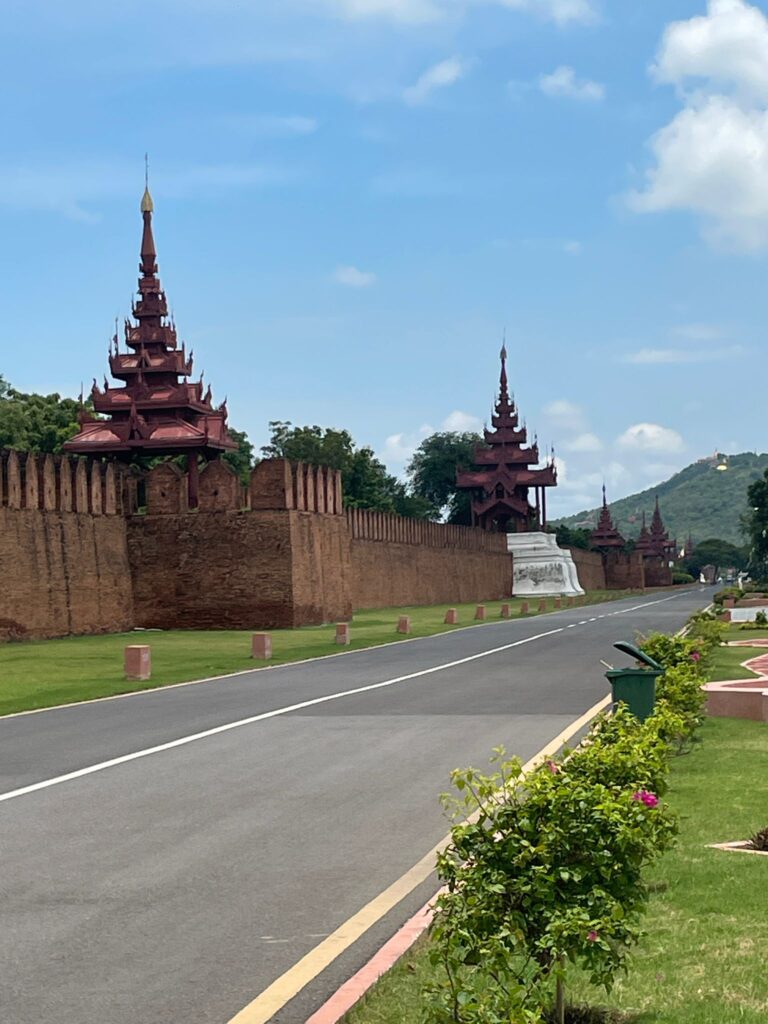


Decision Time: How to Spend my Final Days Visiting Myanmar
With 3 days left I was at a crossroads. I was already bored of Mandalay and wanted to move on. The other popular tourist destination, Inle Lake, seemed to need at least 3 days to explore properly. I didn’t have time to do it justice without a major rush, and decided against this. The other option was Naypyidaw the capital of Myanmar. When visiting Myanmar, the capital isn’t the most popular stop, yet has unique appeal.
Naypyidaw has a reputation for being a ghost city, famous for its 20 lanes into the city and the fact you are unlikely to see another car on the way in. It has a handful of spots said to be worth visiting, but is home to very few locals. Rumour has is that this city was chosen to be the capital as a decoy just in case the US were to invade. They would strike the ghost capital rather than Yangon, the former capital, which is where the majority of important government institutions are located. This would give them a strategic advantage and ensure minimal damage to key personnel and infrastructure. If Naypyidaw were to be wiped off the map overnight, it would be of no great loss to the Burmese military.
However, with the capital being off the regular tourist trail, I decided to not risk being stranded, with trickier logistics and fewer buses between cities which could potentially mean missing my flight back from Yangon.
Back to Yangon and Some Bad News at the Airport
In the end it was time to return to Yangon. The final couple of days were quiet, and I headed to Yangon Yangon, a popular rooftop bar to witness the sunset on what I thought was the final night. There was no sunset but an awful lot of rain. Staff scrambled to put the rain covers on, which were mostly ineffective to begin with as they struggled to secure them. One blew back sending the remainder of my beer flying. I received a full top up of my pint and sat out the storm under the covers, now fully in tact. Soaking wet and the proud owner of a full pint which I had effectively paid half price for. That’s what you call a net win.
The following day was time to leave. All websites had my flight listed as being “on time” leaving me with no concerns. It was time to head to the airport. Upon arrival my flight wasn’t on the board and there were no Airasia staff at the airport.
Okay, no problem. I’m early.
After a while the departures board started listing less flights as more left. And mine was still not there. The information desk saw no issue and said my flight would appear two hours before departure.
With 1.5 hours to go and still no sign of my flight or Airasia at the checkin desks, it was time to speak to the information desk again.
This time they rang someone and told me what I’d come to expect at this stage.
The flight didn’t exist.
Despite (supposedly) daily flights to Kuala Lumpur, my ticket being for this exact date and time, and all websites showing the flight as departing without delay, there was no flight…
Travel Doesn’t Always Go Smoothly
I asked what I could do explaining that I don’t have enough kyat left to stay another night, having ran down my remaining money on the final day. My card didn’t work in Myanmar meaning using that was not an option, and a curfew from midnight until 4am made sleeping in the airport impossible.
On the plus side, online checkin finally worked (a rarity for Airasia) and my flight had been changed for one exactly 24 hours later. So my only issue now was affording a hotel for the night.
The information desk were useless. Several times I asked what could be done and they shrugged their shoulders whilst refusing to offer suggestions. After several minutes of speaking to a brick wall I left the lack-of-information desk and spent half an hour on my phone exploring other options.
Ultimately there were no hotels I could afford with the remaining 10,000 kyat I had. Airport staff away from the lack-of-information desk were much more helpful than their colleagues and were able to call Airasia for me. The airline however were also unhelpful and said they could not cover my accommodation costs, or come up with any alternative solutions.
An hour later and I still had no progress. Then finally, a breakthrough…
The Kindness of Strangers
The kind airport staff who had talked amongst themselves for a while gave me 20,000 kyat to find a hotel. On top of what I had, this was enough to head back to the hostel I had spent the rest of my time in Yangon staying in.
The one digital transaction I had no issues with was ordering taxis with Grab. Payment on the Grab app worked smoothly and I was able to return downtown and sleep ahead of attempt two to leave the country the following day.
Attempt two started with one of the dodgiest taxi rides of my life. The driver was very friendly, yet a horrific driver with no regards for safety. There were no seatbelts and he would drive at speed weaving in and out of traffic. He would often engage in road rage shouting and swearing at anyone unlucky enough to get in his way.
A brief moment of calm followed as he stopped for petrol, before the wild ride continued. After 45 minutes we finally made it to the airport, somehow in one piece and on this occasion, my flight was up on the board. A major positive, if only because it meant not having to risk going back downtown with the taxi madman of Yangon.
A few hours later and it was time to finally leave and return to Malaysia.
Final Thoughts on Visiting Myanmar
Myanmar is certainly no place for the beginner traveller. But anyone who is used to a few grittier countries and lesser developed places should be fine. The dangerous aspects are exaggerated and in reality you will not run into trouble if you stick to the tourist trail. The military will not cause any problems as long as you are careful with what you photograph (nothing government/military-related) and can even be helpful if you overcome the language barrier.
Yangon and Mandalay are safe cities to visit, even if they aren’t quite the safest in Southeast Asia.
Is it a worthwhile country to visit? Absolutely. The stunning pagodas and mystical Bagan are amongst Asia’s finest sights. Visiting Myanmar offers a raw and authentic experience with barely another foreigner in sight.
If you made it this far and enjoyed reading this, I will be making similar posts on every country I visit and much more. I have also posted a logistics report with detailed information on visiting Myanmar.
